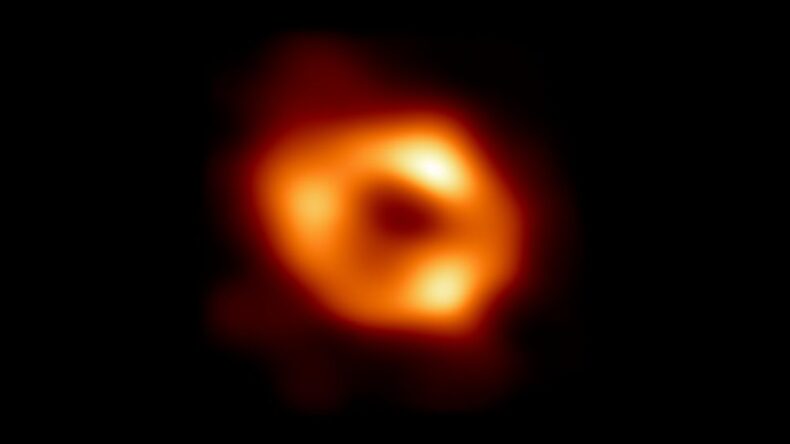The Event Horizon Telescope has caught the first picture ever taken of the supermassive black hole at the heart of our galaxy.
This picture, captured by submillimeter radio waves, reveals the existence of a hydrogen-feeding black hole at the center of the Milky Way.
Thursday at a National Science Foundation press conference, Feryal Ozel, an astronomer from the University of Arizona, said, “Until today, we did not have the direct image to verify that this gentle giant in the heart of our galaxy is a black hole” (May 12). “It reveals a dazzling ring around the blackness and the telltale indication of the black hole’s shadow.”
Ryan Hickox, an astronomer at Dartmouth College who is not a part of the EHT project, told Space.com, “This is an extraordinary accomplishment.” “I believe I speak for the majority of my astronomy colleagues when I express our profound gratitude.”
The Event Horizon Telescope (EHT) made news in 2019 when it captured the first-ever picture of a black hole’s event horizon, especially the black hole at the core of the active elliptical galaxy Messier 87. The EHT made observations of Sagittarius A*, which is the name given to the supermassive black hole at the centre of the Milky Way, at the same time it was gathering data for this picture. However, imaging Sagittarius A* proved more challenging than imaging M87.
The submillimeter radio frequencies on which the EHT depends may be absorbed by the Earth’s water-laden atmosphere. In the intervening 27,000 light-years between us and Sagittarius A*, gas and dust may scatter submillimeter radiation and muddy the picture. Lastly, although M87’s black hole has a voracious hunger and seems brilliant because it consumes a great deal of gas, the flow of material onto Sagittarius A* is considerably weaker, indicating that it is much dimmer.
Ozel said, “Getting to this point was not an easy path.” “It took many years to develop and confirm the vision he had.”
Black holes are the densest things in the universe, and their gravity is so strong that even light cannot escape within a certain distance of a black hole. This “point of no return” is known as the event horizon by scientists.
The EHT can detect light in the form of radio waves from hot gas whirling at the event horizon’s edge. The black hole consumes everything from its immediate surroundings, including gas clouds, asteroids, and even stars that stray too near and are torn apart by gravitational waves.
Nevertheless, Sagittarius A* is starving.
Michael Johnson, a Harvard astronomer, said at an NSF news conference, “Only a trickle of matter makes it all the way to the black hole.” In human terms, that would be equivalent to consuming a single grain of rice every million years.
Why the accretion of gas onto Sagittarius A* is so sluggish has been a mystery for decades, according to Nobel Prize-winning astronomer Andrea Ghez of the University of California, Los Angeles. She continued, “There are many mysteries surrounding the accretion flow and why it is so feeble.”

Ghez was awarded a share of the 2020 Nobel Prize in Physics for determining the mass of Sagittarius A* by monitoring the orbital movements of nearby stars. Ghez and her colleagues determined that the mass was 4,300,000,000 times that of the sun.
Given that the size of the event horizon is proportional to the mass of the black hole, it was able to make a forecast, according to Ghez. “The value of imaging the black hole’s ring is that, if you know the mass and distance to the black hole — or, in other words, the magnitude of the event horizon — you can use this information to compare with theory.”
The new photograph reveals that the event horizon of Sagittarius A* spans 51,8 microarcseconds over the sky.
“Our picture is in extremely close accord with theoretical expectations,” said Ozel, who hailed it as the greatest test of Einstein’s general theory of relativity ever conducted, emphasizing that it passed with flying colours.
“It’s a fantastic laboratory for attempting to comprehend how gravity operates around a gigantic black hole,” Ghez added.

Our explanations for the turbulence seen in the gas ring are more questionable. M87’s black hole is far bigger than Sagittarius A*, thus it takes days for changes to become obvious, but Sagittarius Ablack *’s hole is much smaller, and as material whips about it, the ring’s brightness may vary within minutes.
Johnson remarked of the ring around the event horizon, “It is alive with activity and roiling with tumultuous energy.”
To attempt to explain what they were seeing, the EHT team — comprised of more than 300 academics from 80 universities — ran more than 5 million simulations on supercomputers in an effort to discover a match.
Johnson said, “We were left with just a handful of simulations that explain some of the observed characteristics, but not all of them.” Specifically, the models all expected more and quicker variability than what was seen, which may be related to how gas is accreting onto the ring or how magnetic fields are reacting with this influx.
Hickox reacted to the picture by stating, “It’s quite incredible to see an image of the black hole that we know best, and to see the ring and quantify the size of the shadow so precisely.”
In addition, this picture of Sagittarius A* may now serve as a model for other dormant black holes in the cosmos.
This black hole is more representative of all black holes in the universe than the one in M87, according to Hickox. This is what a random supermassive black hole in a galaxy somewhere in the cosmos might look like if it were captured on camera.
This image of Sagittarius A*, as well as the previous image of the black hole in M87, was made possible by a technique known as Very Long Baseline Interferometry, which enables astronomers to combine data from radio telescopes all over the world as if they were one large telescope, effectively making the EHT the largest telescope on Earth.
At the time of the observations, the network included eight telescopes (including the South Polar Telescope, which was too far south to investigate M87), but three more have since been added. The EHT’s greatest baseline, which is equal to a telescope’s aperture, for watching Sagittarius A* was 6,650 miles (10,700 kilometers) wide due to its arrangement of eight telescopes.
Future investigations will now concentrate on obtaining crisper photos to better comprehend the mechanics of turbulence in the ring around the black hole, as well as how the black hole influences the galaxy’s surroundings.
“This motivates us to create ever more precise measurements and photographs,” said Johnson.
Due to their relatively huge angular size on the sky, Sagittarius A* and the black hole in M87 was the EHT’s two primary targets. Even beyond the EHT’s ability to picture their event horizon, supermassive black holes in neighboring galaxies seem much smaller in the night sky. To be able to do so, the baseline between the two largest points in the EHT’s network would need to be lengthened, or its aperture widened. In this sense, the EHT’s resolution is restricted by the size of the Earth, however, Hickox asserts that there are possibilities beyond Earth.
He told Space.com, “I’ve heard mention of a prospective space-based addition to the EHT, which would considerably improve the total angular resolution.” That would be a wonderful advancement.
Read More-NASA releases audio representing the ‘sound’ of a black hole













